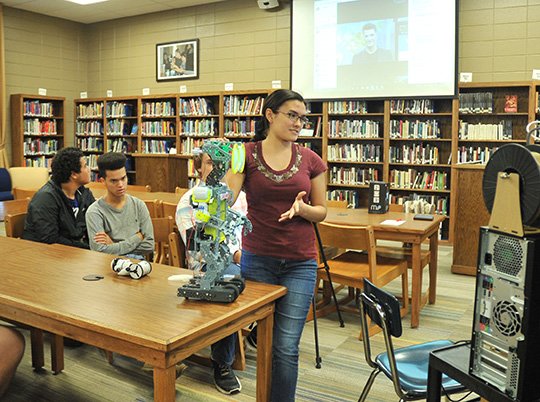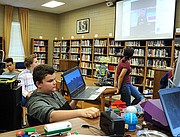Lakeside High School students described their personal projects Tuesday to an executive for Microsoft during a global education outreach event.
The high school was one of more than 40 schools from around the world selected to speak directly with Anthony Salcito, vice president of worldwide education for Microsoft, during the worldwide Skype-a-Thon. Educators from around the world were invited to take virtual field trips, engage in mystery sessions, hear from guest speakers and/or connect with other schools via the internet video call service, Skype.
This year's event marked the third time Salcito pledged to stay awake for 24 hours or more to speak with all of the selected schools consecutively. The 2016 Skype-a-Thon began Tuesday and will continue throughout today.
"Part of the reason I personally do 24 hours is because I just learn so much," Salcito said.
Skype-a-Thon began with Salcito just speaking to schools for 24 hours. Microsoft has since added other components to complement the sessions.
"We have grown this into a much more global movement and I am excited about that," Salcito said. "For me, I love the opportunity to connect and it is fun to see the change we see from classroom to classroom."
Library media specialist Stony Evans connected with Microsoft through social media. Evans said schools had freedom in what they discussed with Salcito, but he wanted students to have a unique chance to showcase their projects to a notable leader.
"Thank you so much for this opportunity to allow us to connect with you," Evans said to Salcito.
Microsoft live streamed Salcito's interactions with schools throughout the day. Lakeside followed Ecole Secondaire Jeunes Sans Frontieres in Brampton, Ontario, Canada, in the broadcast.
Each school asked a question for the next to answer. Lakeside was asked how the school uses Microsoft technology to advance learning. Evans said the school and the library have increasingly utilized Skype to connect with other schools throughout the country and the rest of the world.
Lakeside was followed by Amazing Grace Christian School in Seattle. Microsoft also connected Salcito with students at Hall Fletcher Elementary School in North Carolina, Milton Area School District in Pennsylvania and Woodstock High School in Georgia.
Juniors Zoey Lawless and Madison Schoonover served as the hosts for Lakeside. They provided information about Hot Springs and Lakeside before they presented the other student speakers.
Sophomore Krystyna Valdivia showcased robots she built and explained she may explore careers in robotics in the future. She first displayed a voice-operated robot she built.
"He's mainly for entertainment, but you can also learn things with them," Valdivia said.
Valdivia next showed how she used hand gestures to control another robot she programmed. Salcito said robotics is one of the most exciting areas of technology to him.
"I think there is a long way to go and, certainly, there has been a lot of progress to get the building blocks to program both the natural movements, but also speech," Salcito said.
"The digital systems that we all take for granted on our phones, whether it's Cortana or Siri, these can actually be sort of engines to help robots provide much more intelligence and also interaction. I think that's something you'll see more and more of, both the natural language and gesture controls, using technologies that are in drones to actually power much more smart assistants that we will have naturally in our world."
Jordan Lyle, an eighth-grade student, explained how he used the game Minecraft to virtually create various structures. He said the program can be used as a more fun educational tool than some school assignments.
Salcito suggested students embark on a project to digitally construct their school. He said he recently met a Harvard professor who used Minecraft to recreate tombs in Giza, Egypt.
Freshman Jared Overstreet said he built the school's library in Minecraft and later used the program to build a digital temple for a class project. He said his work helped change the minds of teachers about the educational benefits of the game. Salcito said he has seen educators excited about the flexibility of learning provided by Minecraft.
Four EAST students detailed their work with a 3-D printer. Sophomores Rakeem Aings, Gavin Arnold, Devin Glapion and Andrew Maynard described how they have integrated other technology into the printing and collaborated on projects. Juniors Nathan Evans and Hayden Webb offered examples of their work with BreakoutEDU, Minecraft and other technology.
"We have a great series of Skype sessions throughout today," Salcito said. "There's Skype-a-Thon sessions happening all over the world. It has been really amazing to see. So, thanks for being part of the Skype-a-Thon."
Salcito's sessions also included schools from Australia, Brazil, Canada, Colombia, Czech Republic, Ecuador, El Salvador, England, Hong Kong, India, Indonesia, Israel, Japan, Lebanon, Netherlands, New Zealand, Norway, Puerto Rico, Portugal, Qatar, Russia, Saudi Arabia, Scotland, Slovakia, South Africa, South Korea, Vietnam, Uruguay and Wales.
Local on 11/30/2016

